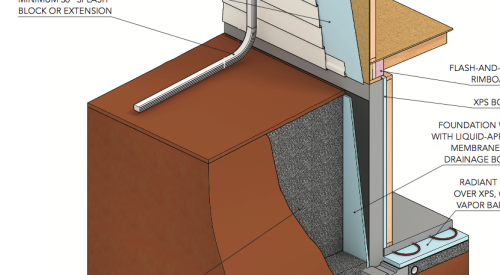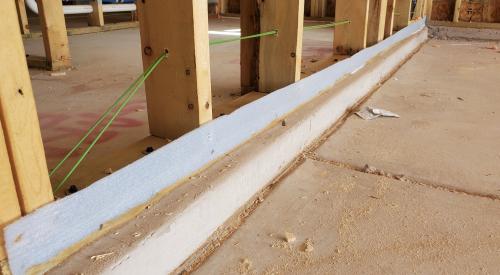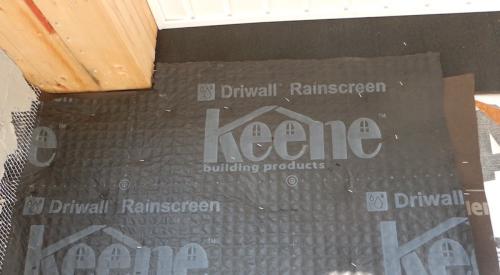|
The first line of defense against mold is preventing the entry of bulk water into building assemblies. If you donÆt win that battle, youÆll lose the war. Yes, if you want a mold-free and durable building, controlling indoor relative humidity requires attention as well. But first things first: It all starts with draining water down and out from all roofs, walls and foundations.
ôMold is a water problem,ö says forensic engineer Joe Lstiburek (Building Science Corp., Westford, Mass.). ôTo beat water problems, the idea is to shed water by layering materials in such a way that water is directed downward and outward, out of and away from the building.ö
This might seem like a keen eye for the obvious, but drive around many new subdivisions today, and it isnÆt hard to spot problems such as dubious surface drainage and essential flashings that are installed improperly if not missing.
To help upgrade and fine-tune current practice, the Energy & Environmental Building Association is publishing the Water Management Guide, a 36-page document written by Lstiburek. ItÆs loaded with drawings and simple text that describe and detail how to do this essential job. Typically youÆll need to tailor some details to your specific application.
Drainage planes
The guide states that all homes in all climates need drainage planes ù surfaces that shed water rather than absorb it. Establishing a drainage plane is a snap with simple roof assemblies but takes more thinking and careful detailing for complex wall and roof intersections. To keep it simpler here, weÆll focus on walls. Note that because oriented strand board wall sheathing absorbs water, it canÆt serve as a drainage plane.
Exterior wall cladding often is supposed to double as the drainage plane. The guide calls this a face-sealed ôbarrierö approach. A barrier system relies on the exterior cladding to shed water for the life of the building. That means penetrations in the exterior cladding, such as doors and windows, require perfectly installed and ageless caulking. With no backup drainage plane behind the barrier, any water that leaks past the face-sealed cladding might cause trouble.
In many wall assemblies, the drainage plane lies inboard of the exterior cladding. In the case of traditional masonry stucco over wood frame, the stucco sheds some water but also absorbs a substantial amount. Single or doubled felt paper located behind the stucco acts as the drainage plane.
Less common but frequently recommended ôscreen assembliesö include a secondary line of defense. Consider the case of brick veneer outside a framed wall, or wood siding attached to furring strips over exterior sheathing. Any water absorbed by the brick or wood can be driven inward by wind and solar heat. But the air space behind the exterior finish promotes drainage and ventilation, and a drainage plane applied over the exterior sheathing provides final protection against water movement. ôA leak is not truly a leak if it drains back to the exterior without wetting a water-sensitive material,ö Lstiburek says.
Windows and doors
Lstiburek cites studies showing that 20% of all windows leak water. If thatÆs hard to believe, remember that windows are just components assembled from individual elements that are susceptible to leakage at joints. And if the window itself doesnÆt leak, most exterior sealants around windows eventually fail. So the key water-management principle ù drain water down and out ù must be applied to all windows.
Exterior window flashings are showing up increasingly on job sites. The trick is proper detailing (see Figure 2). Those details might vary with different products and designs. The critical step is to integrate flashings (installed shingle style) with a drainage plane (installed shingle style) so that any water penetrating the window wonÆt wet the wall.
Do you flash your door openings, especially the sill, to prevent leakage? If not, you should. Among the recommended options, the Water Management Guide lists pan flashings, membrane liners, formable flashings and precast sills in concrete slabs.
Foundations
Dampproofing will slow but not stop the wetting of basement walls. Dampproofing applied to basement walls offers moisture-control benefits by reducing water absorption by those concrete walls. However, it doesnÆt provide a waterproofing function. Waterproofing implies a watertight seal without holes, and thatÆs not feasible. Good-draining materials and good de-sign reduce the need for dampproofing.
Strategies that support dry basements start with use of proper surface slopes, overhangs and gutters. Next comes placement of fast-draining backfill against the wall, capped by a layer of impermeable clay-type soil that reduces penetration by surface water. But downpours that hit sidewalls hard, even beneath well-designed overhangs, occur several times a year in many climates. So any substantial amount of water that drains down next to the wall and through the fast-draining backfill should be collected by a fabric-covered, perforated drainpipe with positive drainage to daylight or a sump pit. Also, a capillary break is needed over the footing so that any water absorbed by the footing doesnÆt wick up and into basement walls.
Worst case, some water gets absorbed. The guide recommends: ôInterior basement insulation systems and finishes should be vapor-permeable in order to allow this penetrating water to pass into the interior space and be removed by the mechanical system.ö This means no vinyl-covered blankets or polyethylene vapor barriers in below-grade applications be-cause they prevent wetted surfaces and insulation from drying to the interior.
To prevent water problems with slabs, place a layer of polyethylene vapor retarder directly beneath the slab and above a coarse-gravel bed. The guide specifies avoiding any sand layer between the poly and the slab, as this would allow water to be trapped in the sand layer by capillary action; where this method is used, water can enter in minutes but take years to dry to the interior. Further, to prevent moldy flooring, the guide points out that slabs shouldnÆt be covered with vinyl or carpet until the slab is giving off less than 0.3 grams of water per square foot per 24 hours of drying time.
While the specific solutions for different building systems might vary a bit from whatÆs shown here, the general drainage principles undoubtedly will apply.
Steve Andrews is a Denver-based energy consultant and freelance writer.










